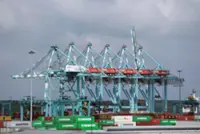A view of Palletrone, an aerial transportation platform developed by Mobile Robotics Lab at Seoul National University of Science and Technology (Seoul Tech) in Seoul, South Korea, October 10, 2024. REUTERS/Kim Soo-hyeon
SEOUL (Reuters) - South Korean researchers have developed a transport drone flying on multiple flexible rotors that self-correct to stay level in flight and can be used as a "flying shopping cart" to carry goods over uneven terrain such as stairs.
The prototype developed by a Seoul National University of Science and Technology team has a cargo platform mounted on top of a multi-rotor drone and is handled by a person using gentle force to guide the hovering aircraft.





